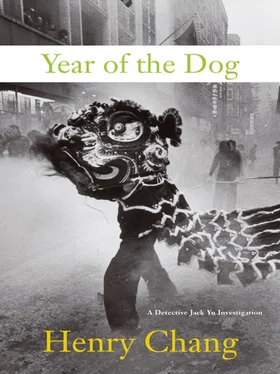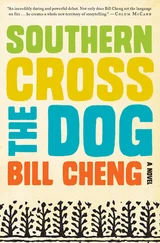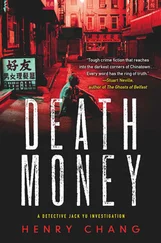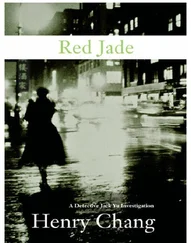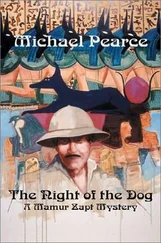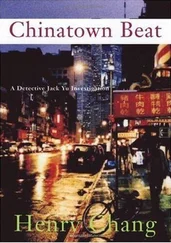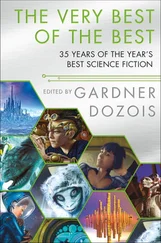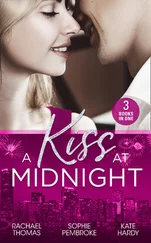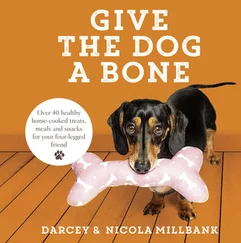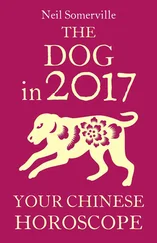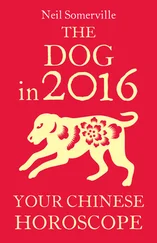Henry Chang - Year of the Dog
Здесь есть возможность читать онлайн «Henry Chang - Year of the Dog» весь текст электронной книги совершенно бесплатно (целиком полную версию без сокращений). В некоторых случаях можно слушать аудио, скачать через торрент в формате fb2 и присутствует краткое содержание. Жанр: Полицейский детектив, на английском языке. Описание произведения, (предисловие) а так же отзывы посетителей доступны на портале библиотеки ЛибКат.
- Название:Year of the Dog
- Автор:
- Жанр:
- Год:неизвестен
- ISBN:нет данных
- Рейтинг книги:3 / 5. Голосов: 1
-
Избранное:Добавить в избранное
- Отзывы:
-
Ваша оценка:
- 60
- 1
- 2
- 3
- 4
- 5
Year of the Dog: краткое содержание, описание и аннотация
Предлагаем к чтению аннотацию, описание, краткое содержание или предисловие (зависит от того, что написал сам автор книги «Year of the Dog»). Если вы не нашли необходимую информацию о книге — напишите в комментариях, мы постараемся отыскать её.
Year of the Dog — читать онлайн бесплатно полную книгу (весь текст) целиком
Ниже представлен текст книги, разбитый по страницам. Система сохранения места последней прочитанной страницы, позволяет с удобством читать онлайн бесплатно книгу «Year of the Dog», без необходимости каждый раз заново искать на чём Вы остановились. Поставьте закладку, и сможете в любой момент перейти на страницу, на которой закончили чтение.
Интервал:
Закладка:
Henry Chang
Year of the Dog
The Dog is the eleventh sign, next to last in the lunar cycle, the most likeable of all the animals. The Dog is fearless, charismatic, and believes in justice, loyalty, and fidelity.
The year is characterized in the masculine Yang, by struggle, perseverance, and faith.
0 — N i n e
The Ninth Precinct started at the East River, and ran west to Broadway. On the north it was bounded by Fourteenth Street; on the south, Houston. Within these confines, the neighborhoods were the East Village, Loisaida, NoHo, Alphabet City, and Tompkins Square. Anarchists, artists, students, and the low-income working class all lived together, sometimes tenuously, until their breaking points made the Daily News headlines.
The detectives who worked in the Ninth were accustomed to dealing with multicultural scenarios, the daily struggles of blacks and whites, browns and yellows. The scattered Asian presence within its boundaries consisted mostly of hole-in-the wall Chinese take-out joints, Korean delis and dry cleaners, Japanese sushi spots, and even what was probably the last Chinese hand laundry in New York. In the Village, Southeast Asians peddled T-shirts, punk-rock jewelry, and drug paraphernalia. Indians and Pakistanis ruled over the newspaper stands.
Jack Yu had been assigned to the Ninth to cover the holidays. He leaned back from his computer desk in the detective’s area and closed his eyes. On Thanksgiving Day, the last hour of the overnight shift was the longest. His nagging fatigue was spiked with uneasy anticipation.
Homicides in Manhattan South, or diverted from Major Case, were only a phone call away.
He pressed his trigger finger against his temple, working tight little circles there. Computer statistics scrolled dimly inside his forehead, the blunt, logical CompStat analysis of why and how people killed each other in New York City.
There were hundreds of murders in the five boroughs each year; closer to two thousand in the early days of crack cocaine. The records indicated that people killed because of:
Disputes 28 %
Drugs 25 %
Domestic violence 13 %
Robbery/Burglary 12 %
Revenge 10 %
Gang related 8 %
Unknown 4 %
Entire lifetimes were reduced to an NYPD short list of cold percentages, time and location, gender and ethnicity.
Just the facts . Leave the speculation to the beat dicks.
The statistics indicated that women were more likely than men to murder a spouse or lover, and:
Male killers favored firearms over all other weapons.
Brooklyn, a.k.a. Crooklyn, had more killings citywide than any of the other five boroughs. 46 %.
Saturday was the most popular day both for killing and dying.
Men and boys perpetrated 90 % of the murders.
The deadliest hour was between one and two AM .
In half the cases, the killer and victim knew each other.
In 75 % of cases, the perp and the vic were of the same race.
Homicides were concentrated in poorer neighborhoods.
Most of the killers had criminal records.
A third of homicides went unsolved.
Asians, who made up 11 percent of the city’s population, accounted for 4 percent of the victims, and oddly enough, for 4 percent of the killers. The number four, in spoken Chinese, sounded like the word for to die .
Jack knew working the Ninth Precinct, the 0-Nine , wouldn’t be like working anticrime in Brownsville, or East New York, where killings were commonplace, and cops were used to tabulating bodies on a weekly basis. The 0-Nine, according to the Compstat analysis, didn’t have a lot of homicides, but kept pace with other precincts with regards to all other types of incidences, like armed robberies, burglaries, domestic disputes, teen violence, and drug dealing.
He grabbed at and massaged the knotted cords in the back of his neck, taking a deep boxer’s breath through his nose.
The 0-Nine house seemed to be a good fit for him, a welcome surprise. He wasn’t expecting any of the problems he’d had in the Fifth Precinct. He figured that his exploits there, which had earned him a gold shield, would have preceded him to the new stationhouse, earning him a small measure of respect.
Jack got up from the desk and went toward the rear window, smoothly swinging his hips and legs down into a long bridge squat, a Shaolin-style stretch. His lower joints and ligaments popped as he straightened up, watching the frozen gray Alphabet City morning seep in through the window.
One call came into the precinct. A junkie from the projects had been found dead of an apparent drug overdose in an Avenue D shooting gallery, but Narcotics swept it up as part of a larger operation. The dead junkie was their CI, their confidential informant.
The remainder of the shift passed quietly, punctuated only by crackling voices from the squad radio at the duty desk out front. Nobody killed anyone in the precinct on this overnight shift, but on the Lower East Side, Jack knew, violence was only one wrong look, one bad intention away.
Out by the duty desk, the uniforms of the day shift rolled in.
Jack signed out as they started to muster for roll call. He was thinking of the hot chowder at Kim’s when the first frigid gust of East River wind slapped him in the face.
Bodega Koreano
Kim’s Produce was a mom-and-pop Korean deli on Tenth Street, a few blocks from the Ninth Precinct stationhouse. It was 9:18 AM on the Colt 45 display clock, well past his twelve-hour tour, when Jack joined the cashier’s line with his take-out container of hot clam chowder. A small television set showed the Thanksgiving Day parade. He sipped the steaming soup as he waited, watching the TV. Jack had mixed thoughts about the holiday seasons in the city. These were celebrations, but for many people the seasons were very sad times. There were two cities here-one rich, one poor, each spiritually if not physically segregated from the other.
Jack watched the Macy’s Parade march down Central Park West, past the stately and formidable buildings whose names rolled out: Majestic, Prasada, Dakota, San Remo, the landmarks of the rich and fabulous, private balconies with front-row views. The majorettes fronting the marching bands moved briskly down through the Twentieth Precinct, toward the old Mayflower Hotel, then on past Trump International, where top-shelf guests reserved midlevel suites for holiday packages at a thousand a night, so that their children would be thrilled by the giant cartoon balloons floating past their floor-to-ceiling double-paned glass windows. The Pink Panther. The Cat in the Hat. Barney the Dinosaur. Sonic the Hedgehog, who had an appetite for lampposts along Central Park.
Down below, at street level, two million of the hoi polloi gathered along the parade route, crowded and penned-in along the sidewalks, in the bitter cold. Tourists and middle-class families from the outer boroughs saw the floats rolling by-Big Bird and Santa Claus, and comic-book heroes floating in the sky.
The parade moved south toward Times Square, passing through the Midtown Commands, Manhattan North and Manhattan South. It would all end, Jack knew, at the Macy’s store at Herald Square, where there would be backup from the Tenth and Thirteenth Precincts, and, of course, plenty of overtime uniforms managing the crowds, working the barricades and the subways.
Much farther downtown, Jack knew, there were no luxurious hotel rooms, no balloons or floats. On the Lower East Side, Loisaida , the holidays found citizens of the 0-Nine at soup kitchens and food pantries, at the Bowery Mission, where the hungry, homeless families and the poor eagerly awaited a traditional hot turkey meal with all the trimmings, with the rest of the citizenry giving thanks, There but for the grace of God go I. Holy Cross, St. Mary’s, St. Mark’s Shelter: Soup kitchens scattered throughout the precinct gave them all something to be thankful for, even for one day.
Читать дальшеИнтервал:
Закладка:
Похожие книги на «Year of the Dog»
Представляем Вашему вниманию похожие книги на «Year of the Dog» списком для выбора. Мы отобрали схожую по названию и смыслу литературу в надежде предоставить читателям больше вариантов отыскать новые, интересные, ещё непрочитанные произведения.
Обсуждение, отзывы о книге «Year of the Dog» и просто собственные мнения читателей. Оставьте ваши комментарии, напишите, что Вы думаете о произведении, его смысле или главных героях. Укажите что конкретно понравилось, а что нет, и почему Вы так считаете.
